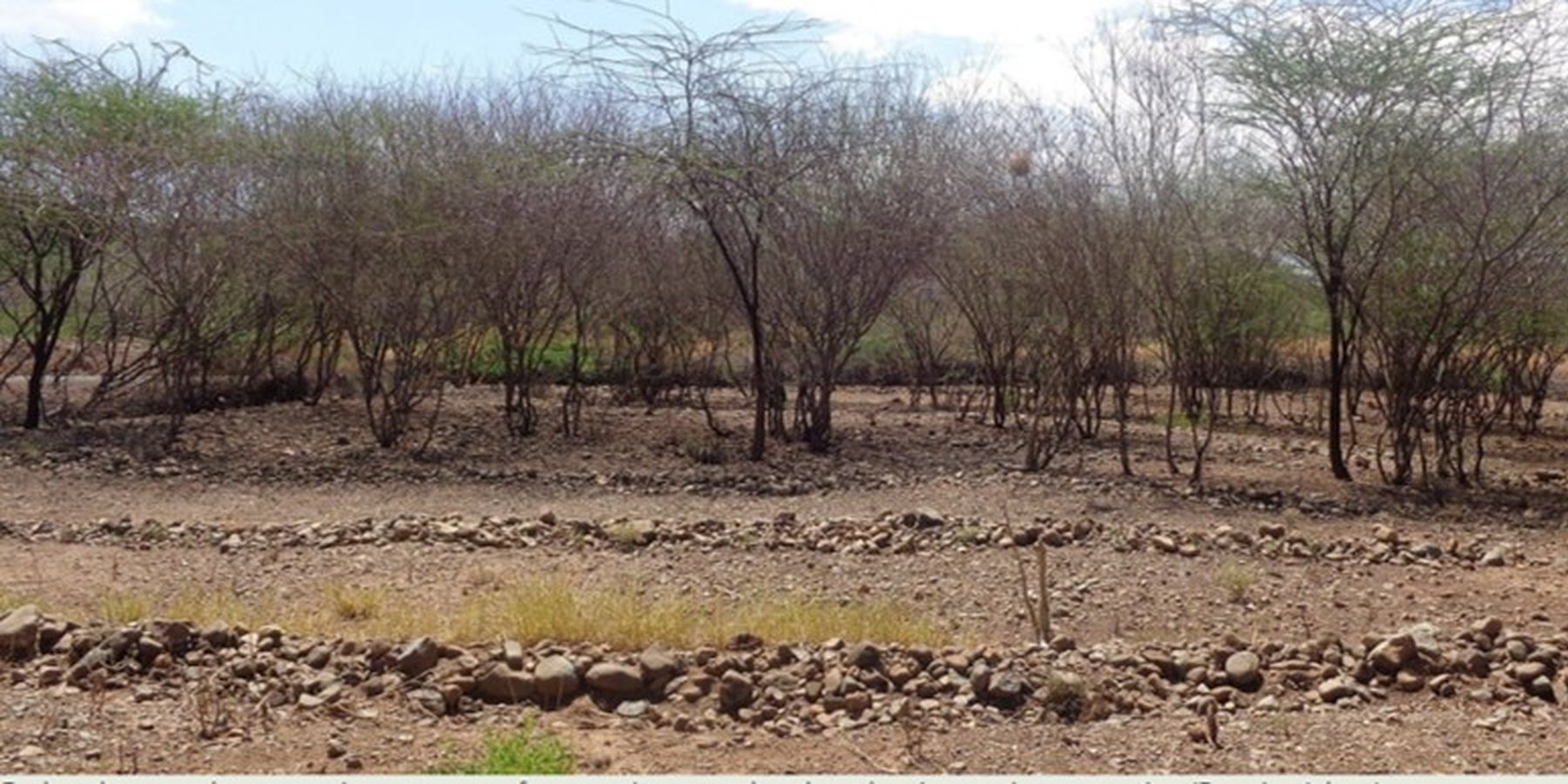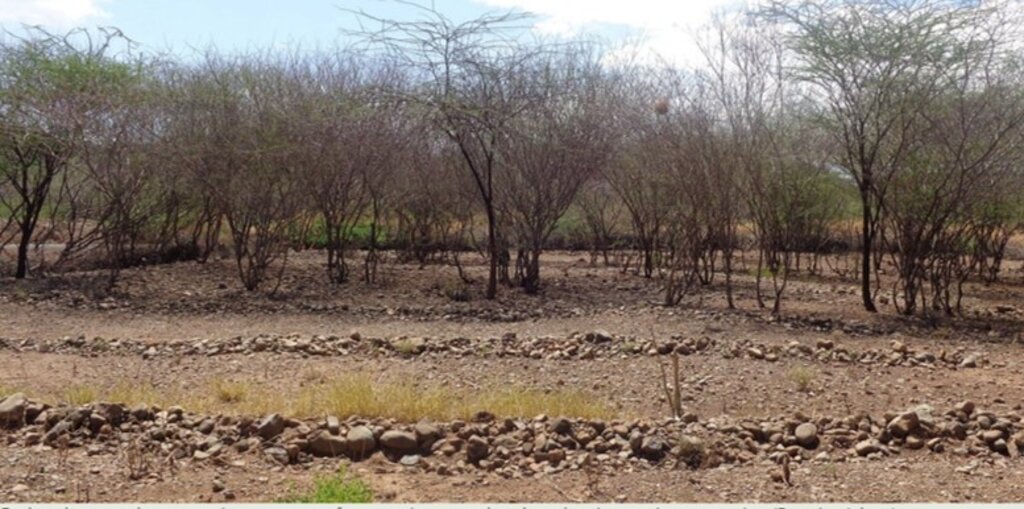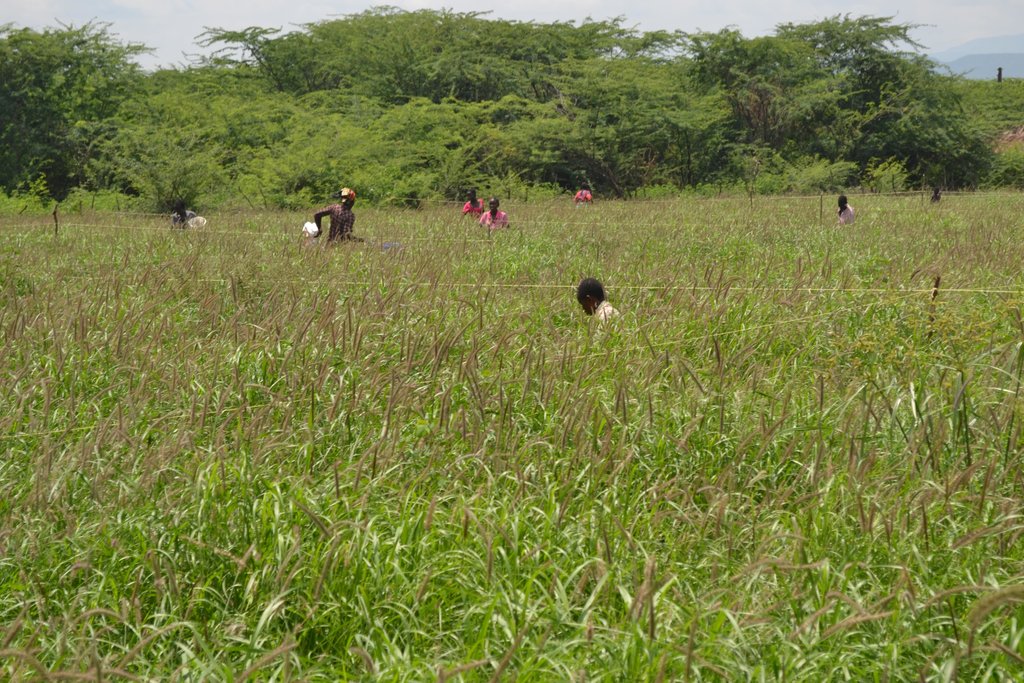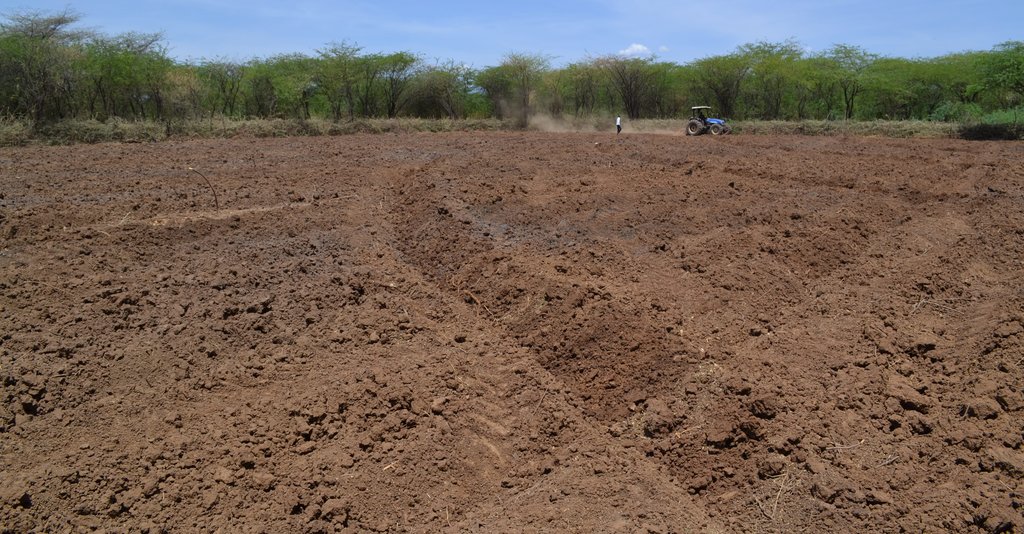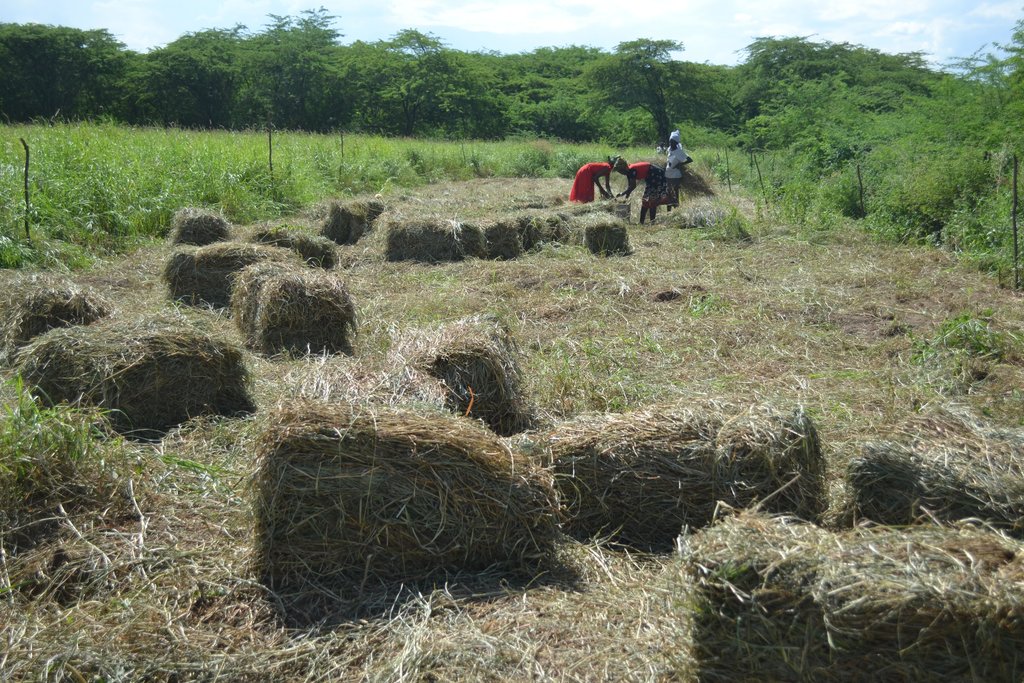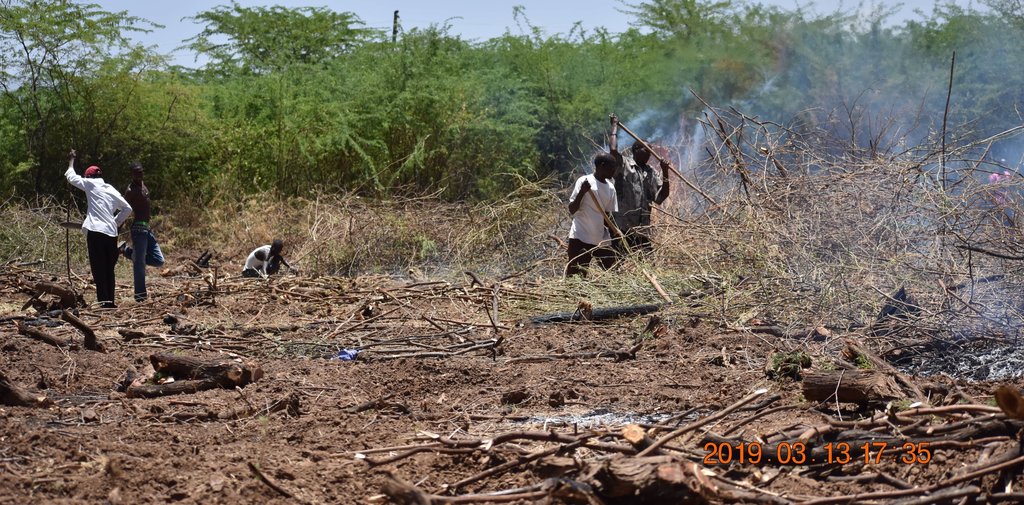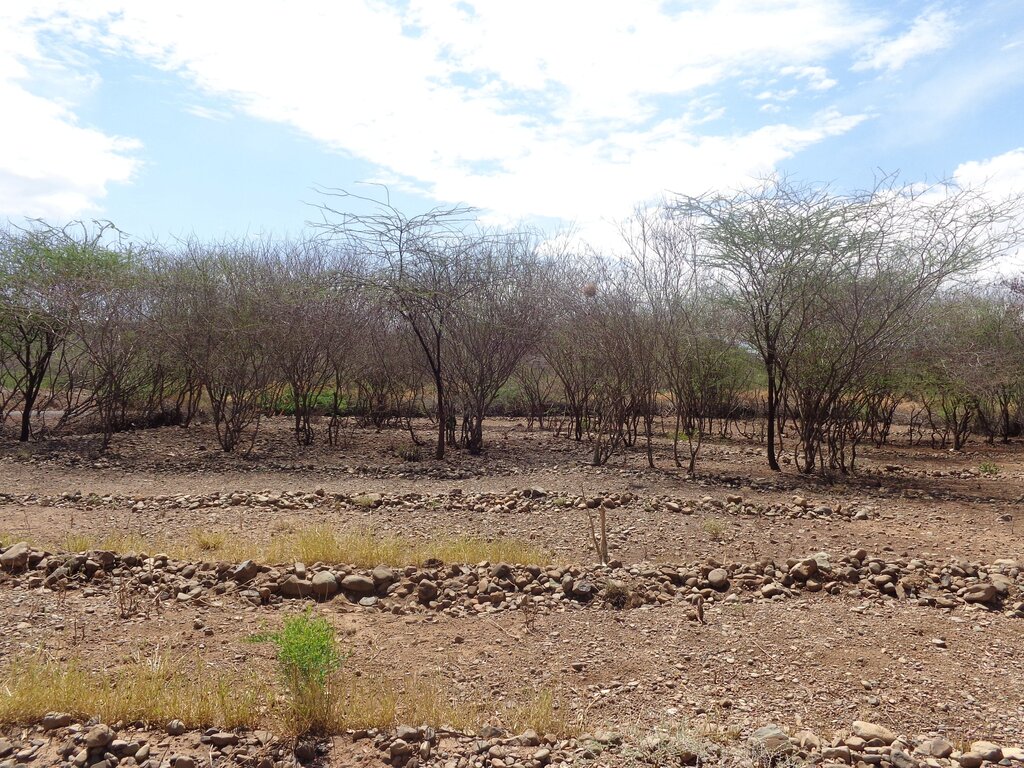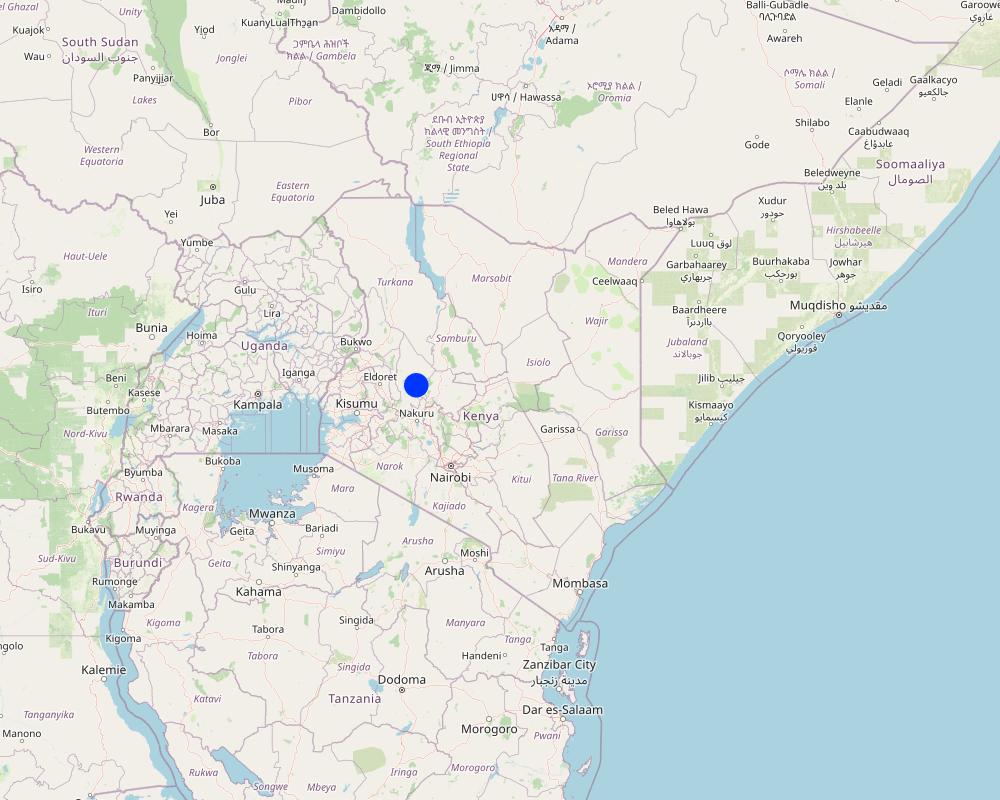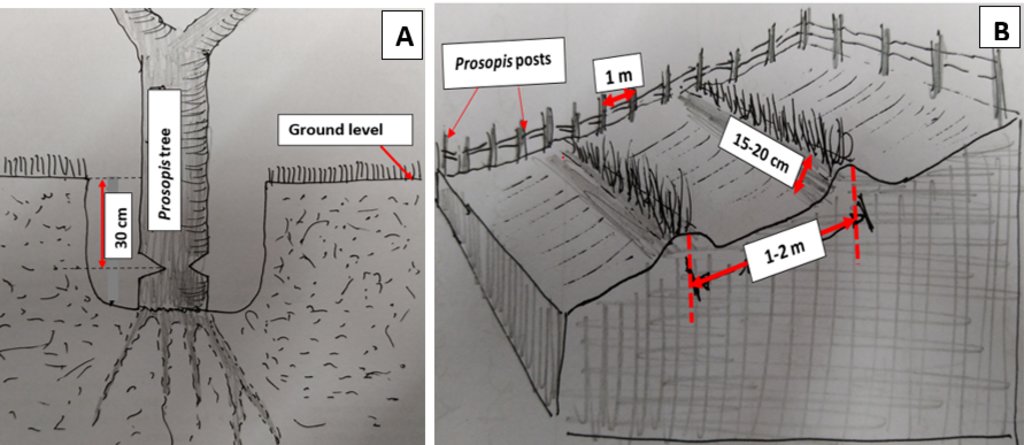Area enclosure : Invasive species management through physical removal and grassland restoration [Kenya]
- Creation:
- Update:
- Compiler: Beatrice Otieno
- Editors: Urs Baumgartner, Christian Hergarten
- Reviewers: Rima Mekdaschi Studer, Rene Eschen
Reseeding
technologies_3454 - Kenya
View sections
Expand all Collapse all1. General information
1.2 Contact details of resource persons and institutions involved in the assessment and documentation of the Technology
Key resource person(s)
land user:
Meigiri Esther
+254 712387590
NA
Local community member of Marigat Sub-County, Kenya
Kenya
land user:
Grace Chemutai
+254 700865828
NA
Local community member of Marigat Sub-County, Kenya
Kenya
Name of project which facilitated the documentation/ evaluation of the Technology (if relevant)
R4D Woody WeedsName of the institution(s) which facilitated the documentation/ evaluation of the Technology (if relevant)
Centre for Training and Integrated Research in ASAL Development (CETRAD) - Kenya1.3 Conditions regarding the use of data documented through WOCAT
When were the data compiled (in the field)?
15/11/2019
The compiler and key resource person(s) accept the conditions regarding the use of data documented through WOCAT:
Yes
1.4 Declaration on sustainability of the described Technology
Is the Technology described here problematic with regard to land degradation, so that it cannot be declared a sustainable land management technology?
No
2. Description of the SLM Technology
2.1 Short description of the Technology
Definition of the Technology:
Area enclosures are a set of restoration strategies through which land is cleared of invasive species, restored using a combination of agronomic, structural, and vegetative measures, and surrounded by barriers to restrict unauthorized entry and minimize disturbance.
2.2 Detailed description of the Technology
Description:
Area enclosures are sustainable land management (SLM) technologies implemented locally to rehabilitate land invaded by species such as Prosopis juliflora and prevent further re-invasion. They are crucial in preventing, controlling, and restoring of Prosopis management and are preferred for their cost-effectiveness, offering significant financial, environmental, and social benefits. Enclosures improve land aesthetics, diversify income sources in pastoral economies—such as through the sale of grass seeds and fodder—and help reduce conflicts over grazing land. In Baringo, several women have reported improved livelihoods and livestock acquisition from income generated by selling grass products.
The implementation of this SLM technology involves several steps: Established Prosopis trees are manually cut and uprooted using simple tools like machetes and hoes, with roots removed about 30 cm below the soil surface to prevent coppicing. This labor-intensive process can be hindered by inefficient equipment, potentially increasing costs. Barriers are then erected around the cleared land to restrict access by livestock and unauthorized individuals, often using tree branches for fencing. A tractor plows and ridges the land to create ridges that enhance water infiltration, with stone bunds placed along the edges to slow water flow and reduce soil erosion. Grass seeds are sown on ridge risers to form grass strips, with sowing timed for the rainy season to ensure optimal germination. While the Ministry of Agriculture provides seeds, local farmers may also sell them, as supply can sometimes fall short of demand. Additionally, native plants like acacia are intercropped with grass to offer extra ground cover and shade, reducing soil water evaporation.
2.3 Photos of the Technology
2.5 Country/ region/ locations where the Technology has been applied and which are covered by this assessment
Country:
Kenya
Region/ State/ Province:
Baringo County
Further specification of location:
Ngambo Sub-Location, Marigat Sub- County
Map
×2.6 Date of implementation
Indicate year of implementation:
2019
2.7 Introduction of the Technology
Specify how the Technology was introduced:
- through projects/ external interventions
Comments (type of project, etc.):
The project was established by an NGO, the Rehabilitation of Arid Environments Charitable Trust (RAE) in collaboration with the community to restore degraded land and enhance human livelihoods in Baringo by providing alternative sources of income. Local participants in the Woody Weeds project adopted the technology for implementation so as to evaluate its effect in managing invasive species while at the same time, enhancing human livelihoods.
3. Classification of the SLM Technology
3.1 Main purpose(s) of the Technology
- improve production
- reduce, prevent, restore land degradation
- preserve/ improve biodiversity
- create beneficial economic impact
3.2 Current land use type(s) where the Technology is applied

Cropland
- Perennial (non-woody) cropping
Main crops (cash and food crops):
Grasses for fodder and grass seeds

Grazing land
Intensive grazing/ fodder production:
- Cut-and-carry/ zero grazing
- Improved pastures
If land use has changed due to the implementation of the Technology, indicate land use before implementation of the Technology:
Before Prosopis invasion, the area was part of the Perkerra irrigation scheme. Due to climate changes, the streams progressively dried making the land unsuitable for crop production and vulnerable to Prosopis invasion. Likewise, frequent flooding of the area forced community members to abandon flooded parcels, which were subsequently invaded
3.3 Further information about land use
Water supply for the land on which the Technology is applied:
- rainfed
Number of growing seasons per year:
- 1
Specify:
The grass is grown once at the beginning of the restoration and is continuously harvested for 4 to 5 years before re-planting as it naturally re-vegetates after harvesting.
3.4 SLM group to which the Technology belongs
- area closure (stop use, support restoration)
- pastoralism and grazing land management
3.5 Spread of the Technology
Specify the spread of the Technology:
- applied at specific points/ concentrated on a small area
Comments:
The technology is applied by households in small scale covering an average of between 1 to 5 ha per household.
3.6 SLM measures comprising the Technology

agronomic measures
- A1: Vegetation/ soil cover
- A2: Organic matter/ soil fertility
- A3: Soil surface treatment
- A5: Seed management, improved varieties

vegetative measures
- V2: Grasses and perennial herbaceous plants
- V4: Replacement or removal of alien/ invasive species

structural measures
- S2: Bunds, banks
- S6: Walls, barriers, palisades, fences

management measures
- M1: Change of land use type
- M5: Control/ change of species composition
3.7 Main types of land degradation addressed by the Technology

biological degradation
- Bs: quality and species composition/ diversity decline
3.8 Prevention, reduction, or restoration of land degradation
Specify the goal of the Technology with regard to land degradation:
- restore/ rehabilitate severely degraded land
4. Technical specifications, implementation activities, inputs, and costs
4.1 Technical drawing of the Technology
4.2 Technical specifications/ explanations of technical drawing
To uproot Prosopis trees, the soil around the stem is dug 30 cm deep, matching the maximum plowing depth of a tractor (Figure A). Depending on the stem's diameter, handheld tools like axes may be used to create a 90-degree notch on two opposite sides of the stem before cutting it with a chainsaw. A notch is a V-shaped cut or groove made on opposite sides of the tree's stem. This notch is created with an axe to weaken the tree and guide the direction in which it will fall when the tree is cut down with a chainsaw. The notch helps ensure that the tree falls in a controlled manner, reducing the risk of accidents and making the uprooting process more efficient.
Ridges are formed by a light tractor at a depth of 15 to 20 cm to minimize soil displacement and reduce erosion, with the depth adjusted according to the slope gradient. Shallower depths are often recommended for steeper slopes. The resulting furrows are spaced 1 to 2 meters apart and run parallel to the slope (Figure B) to help retain water and improve infiltration. Additionally, live fence poles are placed 1 meter apart to strengthen the enclosure. These live posts, made from tree stems, can grow roots and continue to thrive after being planted, helping to stabilize the soil, provide shade, and enhance the overall resilience of the enclosure.
4.3 General information regarding the calculation of inputs and costs
Specify how costs and inputs were calculated:
- per Technology area
Indicate size and area unit:
1 ha
other/ national currency (specify):
KES
Indicate exchange rate from USD to local currency (if relevant): 1 USD =:
110.0
Indicate average wage cost of hired labour per day:
KES 500
4.4 Establishment activities
| Activity | Type of measure | Timing | |
|---|---|---|---|
| 1. | Clearance of land | Agronomic | Once |
| 2. | Fencing/ Enclosure | Structural | Once a year |
| 3. | Ploughing | Agronomic | Once at the beginning of the project |
| 4. | Ridging | Agronomic | Once at the beginning of the project |
| 5. | Stone bund development | Structural | Once at the beginning of the project |
| 6. | Sowing | Agronomic | Once at the beginning of the project in 4 to 5 years |
| 7. | Removal of all Prosopis seedlings while small | Agronomic | Repeatedly, but mostly during early stage of technology |
| 8. | "Common" weeding | Agronomic | Twice a year, with more frequent removal of seedlings recommended while they are still small in the early stages, until the seed bank is depleted. |
4.5 Costs and inputs needed for establishment
| Specify input | Unit | Quantity | Costs per Unit | Total costs per input | % of costs borne by land users | |
|---|---|---|---|---|---|---|
| Labour | Uprooting of Prosopis trees | Man-days | 96.0 | 500.0 | 48000.0 | 100.0 |
| Labour | Fencing | Man-days | 38.0 | 500.0 | 19000.0 | 100.0 |
| Labour | Planting | Man-days | 30.0 | 100.0 | 3000.0 | 100.0 |
| Equipment | Ploughing tractor | Hours | 6.0 | 420.0 | 2520.0 | 100.0 |
| Equipment | Ridging | Hours | 6.0 | 420.0 | 2520.0 | 100.0 |
| Equipment | Chain-saw hire | Fuel-tank used | 13.0 | 600.0 | 7800.0 | 100.0 |
| Plant material | Grass seeds | kg | 1.0 | 3000.0 | 3000.0 | |
| Total costs for establishment of the Technology | 85840.0 | |||||
If land user bore less than 100% of costs, indicate who covered the remaining costs:
The woody weeds project
4.6 Maintenance/ recurrent activities
| Activity | Type of measure | Timing/ frequency | |
|---|---|---|---|
| 1. | Weeding | Agronomic | Twice a year, but at the initial stages, there may be need for more frequent removal of young seedlings until the Prosopis seedbank in the soil is depleted. |
| 2. | Ridging | Structural | once or twice a year depending on the status of the ridges |
| 3. | Harvesting | Agronomic | Three times a year |
4.7 Costs and inputs needed for maintenance/ recurrent activities (per year)
| Specify input | Unit | Quantity | Costs per Unit | Total costs per input | % of costs borne by land users | |
|---|---|---|---|---|---|---|
| Labour | Weeding | Man-hour | 90.0 | 100.0 | 9000.0 | 100.0 |
| Labour | Ridging | Man-hour | 60.0 | 100.0 | 6000.0 | 100.0 |
| Labour | Harvesting | Man-hour | 50.0 | 100.0 | 5000.0 | 100.0 |
| Labour | Stone bunds | Man-hour | 6.0 | 100.0 | 600.0 | 100.0 |
| Total costs for maintenance of the Technology | 20600.0 | |||||
4.8 Most important factors affecting the costs
Describe the most determinate factors affecting the costs:
1. Density of Prosopis invasion
2. Size of the farm area
3. Size of Prosopis trees
5. Natural and human environment
5.1 Climate
Annual rainfall
- < 250 mm
- 251-500 mm
- 501-750 mm
- 751-1,000 mm
- 1,001-1,500 mm
- 1,501-2,000 mm
- 2,001-3,000 mm
- 3,001-4,000 mm
- > 4,000 mm
Agro-climatic zone
- semi-arid
The area is in a semi-arid zone, with temperatures ranging from 16 to 36 degrees Celsius. The average annual rainfall is 670 mm and highly erratic. Annual evaporation rates are much higher and ranging from 2000 mm to 2800 mm.
5.2 Topography
Slopes on average:
- flat (0-2%)
- gentle (3-5%)
- moderate (6-10%)
- rolling (11-15%)
- hilly (16-30%)
- steep (31-60%)
- very steep (>60%)
Landforms:
- plateau/plains
- ridges
- mountain slopes
- hill slopes
- footslopes
- valley floors
Altitudinal zone:
- 0-100 m a.s.l.
- 101-500 m a.s.l.
- 501-1,000 m a.s.l.
- 1,001-1,500 m a.s.l.
- 1,501-2,000 m a.s.l.
- 2,001-2,500 m a.s.l.
- 2,501-3,000 m a.s.l.
- 3,001-4,000 m a.s.l.
- > 4,000 m a.s.l.
Indicate if the Technology is specifically applied in:
- not relevant
5.3 Soils
Soil depth on average:
- very shallow (0-20 cm)
- shallow (21-50 cm)
- moderately deep (51-80 cm)
- deep (81-120 cm)
- very deep (> 120 cm)
Soil texture (topsoil):
- medium (loamy, silty)
Soil texture (> 20 cm below surface):
- medium (loamy, silty)
Topsoil organic matter:
- medium (1-3%)
5.4 Water availability and quality
Ground water table:
< 5 m
Availability of surface water:
medium
Water quality (untreated):
poor drinking water (treatment required)
Is water salinity a problem?
No
Is flooding of the area occurring?
Yes
Regularity:
frequently
5.5 Biodiversity
Species diversity:
- low
Habitat diversity:
- low
5.6 Characteristics of land users applying the Technology
Sedentary or nomadic:
- Sedentary
Market orientation of production system:
- mixed (subsistence/ commercial
Off-farm income:
- 10-50% of all income
Relative level of wealth:
- poor
- average
Individuals or groups:
- individual/ household
Level of mechanization:
- manual work
- mechanized/ motorized
Age of land users:
- middle-aged
5.7 Average area of land owned or leased by land users applying the Technology
- < 0.5 ha
- 0.5-1 ha
- 1-2 ha
- 2-5 ha
- 5-15 ha
- 15-50 ha
- 50-100 ha
- 100-500 ha
- 500-1,000 ha
- 1,000-10,000 ha
- > 10,000 ha
Is this considered small-, medium- or large-scale (referring to local context)?
- small-scale
- medium-scale
5.8 Land ownership, land use rights, and water use rights
Land ownership:
- communal/ village
Land use rights:
- communal (organized)
Water use rights:
- open access (unorganized)
5.9 Access to services and infrastructure
health:
- poor
- moderate
- good
education:
- poor
- moderate
- good
technical assistance:
- poor
- moderate
- good
employment (e.g. off-farm):
- poor
- moderate
- good
markets:
- poor
- moderate
- good
energy:
- poor
- moderate
- good
roads and transport:
- poor
- moderate
- good
drinking water and sanitation:
- poor
- moderate
- good
financial services:
- poor
- moderate
- good
6. Impacts and concluding statements
6.1 On-site impacts the Technology has shown
Socio-economic impacts
Production
fodder production
Quantity before SLM:
0 bales of fodder/ha
Quantity after SLM:
32 bales of fodder/ha
Comments/ specify:
Income from fodder: 32 x 300 KES = 9600 KES
animal production
Comments/ specify:
Enhanced livestock productivity due to availability of high quality fodder across seasons
product diversity
Quantity before SLM:
0 products
Quantity after SLM:
3 products (fodder, grass seeds, and charcoal, the latter being optional)
Comments/ specify:
Charcoal production only during establishment, when prosopis trees are removed
land management
Comments/ specify:
Grassland restoration ensures improved ground cover which reduces soil erosion
energy generation
Quantity before SLM:
0 bags of charcoal
Quantity after SLM:
37 bags of charcoal
Comments/ specify:
Prosopis trees uprooted during land preparation are used for charcoal production.
Income and costs
expenses on agricultural inputs
Quantity before SLM:
0 KES
Quantity after SLM:
95,300 KES
farm income
Quantity before SLM:
0
Quantity after SLM:
KES 45,600
diversity of income sources
Quantity before SLM:
0 sources of income
Quantity after SLM:
3 income sources from sale of fodder, grass seeds, and charcoal
workload
Comments/ specify:
Activities involved in this technology are tedious especially during land preparation and harvesting
Socio-cultural impacts
food security/ self-sufficiency
community institutions
Comments/ specify:
A number of women groups have been established, whose members collectively support each other during implementation of the SLM.
SLM/ land degradation knowledge
Comments/ specify:
Most of the practicing households have learnt of the SLM from their neighbors and community group members, e.g., women groups. This enhances awareness creation on land degradation and respective management options.
conflict mitigation
Comments/ specify:
Grassland restoration results into self sufficient household minimizing competition for communally shared grazing land hence minimizing conflicts.
Ecological impacts
Soil
soil cover
Comments/ specify:
Restored lands are often covered by grass which lowers the impact of rain water on the soil hence reducing soil erosion.
soil organic matter/ below ground C
Comments/ specify:
Mbaabu et al. 2020 (https://doi.org/10.1038/s41598-020-77126-7) have demonstrated that carbon sequestration by grasslands is comparable to that of Prosopis. Therefore, substituting Prosopis with grass is unlikely to significantly affect carbon sequestration benefits. This suggests that replacing Prosopis with grass can maintain carbon sequestration benefits while reducing the negative impacts of Prosopis, resulting in a net positive gain.
6.2 Off-site impacts the Technology has shown
Comments regarding impact assessment:
In the very short term, surface soil ersosion and downstream deposition may increase due to clearing work, while in the longer term, if properly managed, erosion is expected to decrease due to vegetation cover management.
6.3 Exposure and sensitivity of the Technology to gradual climate change and climate-related extremes/ disasters (as perceived by land users)
Gradual climate change
Gradual climate change
| Season | Type of climatic change/ extreme | How does the Technology cope with it? | |
|---|---|---|---|
| seasonal rainfall | wet/ rainy season | increase | well |
Climate-related extremes (disasters)
Climatological disasters
| How does the Technology cope with it? | |
|---|---|
| drought | well |
Hydrological disasters
| How does the Technology cope with it? | |
|---|---|
| general (river) flood | not well at all |
6.4 Cost-benefit analysis
How do the benefits compare with the establishment costs (from land users’ perspective)?
Short-term returns:
slightly negative
Long-term returns:
positive
How do the benefits compare with the maintenance/ recurrent costs (from land users' perspective)?
Short-term returns:
positive
Long-term returns:
very positive
6.5 Adoption of the Technology
- 10-50%
Of all those who have adopted the Technology, how many have did so spontaneously, i.e. without receiving any material incentives/ payments?
- 50-90%
6.6 Adaptation
Has the Technology been modified recently to adapt to changing conditions?
No
6.7 Strengths/ advantages/ opportunities of the Technology
| Strengths/ advantages/ opportunities in the land user’s view |
|---|
| Diversification of income sources hence improving human livelihoods and well being. |
| Economic benefits are derived from extra related activities such as charcoal burning from cleared Prosopis trees during land preparation. |
| Less physical activities in subsequent years after initial planting season making it less tedious and easy to maintain. |
| Strengths/ advantages/ opportunities in the compiler’s or other key resource person’s view |
|---|
| Improved vegetation regeneration and enhanced recovery of restored degraded land due to restricted human and livestock disturbances . |
| Enhanced land management measures speeds up rehabilitation strategy as well as mitigating soil erosion. |
| Suitable for management of invasive species such as Prosopis since land is not left idle for re-invasion. |
6.8 Weaknesses/ disadvantages/ risks of the Technology and ways of overcoming them
| Weaknesses/ disadvantages/ risks in the land user’s view | How can they be overcome? |
|---|---|
| Market exploitation by middlemen | Price regulation and enhancing equitable access to market |
| Associated high cost of initial land clearance | Land users should constantly maintain their farms to prevent re-invasion by Prosopis and hence lower the cost of land preparation. |
| Harvesting grass seeds is tedious and costly | Land users should adopt mechanized harvesting |
| Weaknesses/ disadvantages/ risks in the compiler’s or other key resource person’s view | How can they be overcome? |
|---|---|
| The technology is susceptible to environmental shocks and in particular, floods | The implementation of the SLM technology should be compliant with land use plans and disaster prone areas should be avoided. In cases where this is inevitable, suitable structures such as dykes, dams, and canals should be constructed to enhance the resilience of the technology. |
7. References and links
7.1 Methods/ sources of information
- field visits, field surveys
3
- interviews with land users
3
- compilation from reports and other existing documentation
3
7.2 References to available publications
Title, author, year, ISBN:
Jones, M.B and Donnelly, A. (2004). Carbon sequestration in temperate grassland ecosystems and the influence of management, climate and elevated CO 2; Botany Department, Trinity College, University of Dublin, Dublin 2, Ireland
Available from where? Costs?
https://nph.onlinelibrary.wiley.com/doi/epdf/10.1111/j.1469-8137.2004.01201.x
Title, author, year, ISBN:
Gebrehiwot T, Veen AVD (2014) The Effect of Enclosures in Rehabilitating Degraded Vegetation: A Case of Enderta District, Northern Ethiopia. Forest Res 3:128. doi: 10.4172/2168-9776.1000128
Available from where? Costs?
https://www.omicsonline.org/open-access/the-effect-of-enclosures-in-rehabilitating-degraded-vegetation-2168-9776.1000128.php?aid=33063
Title, author, year, ISBN:
Eschen, R., Bekele, K., Jumanne, Y., Kibet, S., Makale, F., Mbwambo, J.R., Megersa, B., Mijay, M., Moyo, F., Munishi, L., Mwihomeke, M., Nunda, W., Nyangito, M., Witt, A., Schaffner, U., ‘Experimental prosopis management practices and grassland restoration in three Eastern African countries,’ CABI Agriculture and Bioscience, 13 July 2023.
Available from where? Costs?
DOI: 10.1186/s43170-023-00163-5
Title, author, year, ISBN:
Restoration of degraded grasslands, but not invasion by Prosopis juliflora, avoids trade-offs between climate change mitigation and other ecosystem services Purity Rima Mbaabu, Daniel Olago, Maina Gichaba, Sandra Eckert, René Eschen, Silas Oriaso, Simon Kosgei Choge, Theo Edmund Werner Linders, Urs Schaffner
Available from where? Costs?
https://www.nature.com/articles/s41598-020-77126-7
Title, author, year, ISBN:
Towards estimating the economic cost of invasive alien species to African crop and livestock production. Eschen, R., Beale, T., Bonnin, J. M., Taylor, B., & 10 additional authors (2021) CABI Agriculture and Bioscience, 2(1).
Available from where? Costs?
https://doi.org/10.1186/s43170-021-00038-7, Free
Title, author, year, ISBN:
Prosopis juliflora management and grassland restoration in Baringo County, Kenya: Opportunities for soil carbon sequestration and local livelihoods. Eschen, R., Bekele, K., Mbaabu, P. R., Eckert, S., (2021) Journal of Applied Ecology, 58(6), 1234-1245.
Available from where? Costs?
https://doi.org/10.1111/1365-2664.13854, Free
7.3 Links to relevant information which is available online
Title/ description:
Nutrient and Sediment Discharge from Southern Plains Grasslands
URL:
https://journals.uair.arizona.edu/index.php/jrm/article/download/7560/7172
Links and modules
Expand all Collapse allLinks
No links
Modules
No modules


